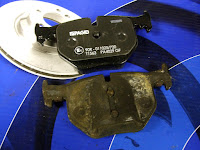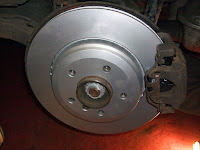--
Since I bought the car the mpg has been gradually worsening, from an initial mpg of 38 down to 32.
The car was also not getting up to temperature any where near quick enough. The car should be up to full running temp in around 3 - 4 miles, with the gauge sitting at the 12 o'clock position. The OBC (on board computer) can be manipulated to show the current engine temperature.
Instructions to access the hidden OBC functions for an E46 BMW 3 Series :
- Hold the trip reset stalk, the left of the two stalks in the dash dial cluster, while turning ignition to the on position
- The OBC should now show "Test" in the top left
- Press the trip reset stalk to scroll through and select function 19.0, this unlocks all the features
- Wait for OBC to show "Off"
- Press the trip reset stalk quickly once
- Then without pausing press the trip reset several times to select function 7, which shows temperature and speed
The ideal temp range is 88 - 92. Mine was reaching 86 after 12 miles of driving.
These symptoms suggested that the thermostat was broken. I did a little research and it was suggested that you change the belts whilst you are at it, as you have to strip the engine back to reveal them anyway.
As the thermostat was coming off, it is necessary to drain the coolant. I was aware that BMW's need specific antifreeze, so I researched into this as well.
I phoned BMW and asked for a price on the antifreeze they supply, for 1.5 litres it came to £9.90. Quite steep when the system takes 10.2 litres of coolant mixture at 50/50 mix. So I looked for an alternative and found Comma's Xstream range. Comma's website suggested G48 for the 330d, so I went and picked up 5L for £19.99. You can see the Comma fact sheet on Xstream G48 here. It was also made clear that distilled water must be used, not ordinary tap water, as this can corrode the system.
I then went and sourced the belts and thermostat from eurocarparts for £70. So, here is the complete parts list ready to be fitted.
First thing to do was get the car jacked up and remove all the engine plastics and the under car covers.
Then remove the fan shroud and viscous fan. You'll need two 32mm spanners, one with a crank in it to get access to the two nuts securing the fan. They are pretty tricky to get to, as you can see below.
To remove the fan shroud you have to use a Torx T20 to undo the screw on the top drivers side. There is also a right pain of a plastic clip to remove on the passenger side. Pull the centre pip out and then the main part.
With the fan and shroud removed I started draining the coolant using the radiator drain plug, expansion tank plug and the engine block drain plug.
I was expecting to get out about 10 litres of coolant, but in actual fact it was no where near. I actually got out about 6 litres, of what looked like discoloured water. It had no smell like antifreeze so I was happy to know that the right mix would be going back into the system.
With the coolant drained I started to remove the thermostat, to get at the fixings I had to undo the top of the intake snorkel and move it over a bit. I also had to remove the EGR pipe.
The thermostat really didn't want to come away from the tubing connected to it, I found I had to undo the two bolts securing the plastic piping.
With the thermostat removed I compared new with old. They differ in design quite a lot, the old one has a considerably more substantial spring. The new one also has a little copper pip that acts as a tiny valve.
Old (left) - New (right)
I fitted the new thermostat and got it all back together before doing the belts, to avoid getting anything in the engine block through the open hole where the thermostat sits.
With that all re-assembled I did the belts. It was very easy on this engine, which was a welcome relief after having a bit of a struggle with the rest of the work.
Belts on, it was time to reassemble the car. Before putting the fan and shroud back on I cleaned them up. Unfortunately I only got pictures of the fan cleaned up.
With everything cleaned up I filled up the coolant system with distilled water and the Comma Xstream G48 in a 50 / 50 mix. The system took about 7 litres, 1 litre more than came out, so it was obviously a little low before.
With the car all back together it started up fine. I took it for a drive and it warmed up as it should in around 3 miles. It also appeared to have a lot more poke, especially at low revs. I cannot understand why this is but a couple of people have said it felt quicker.
All in all a successful job.


























































